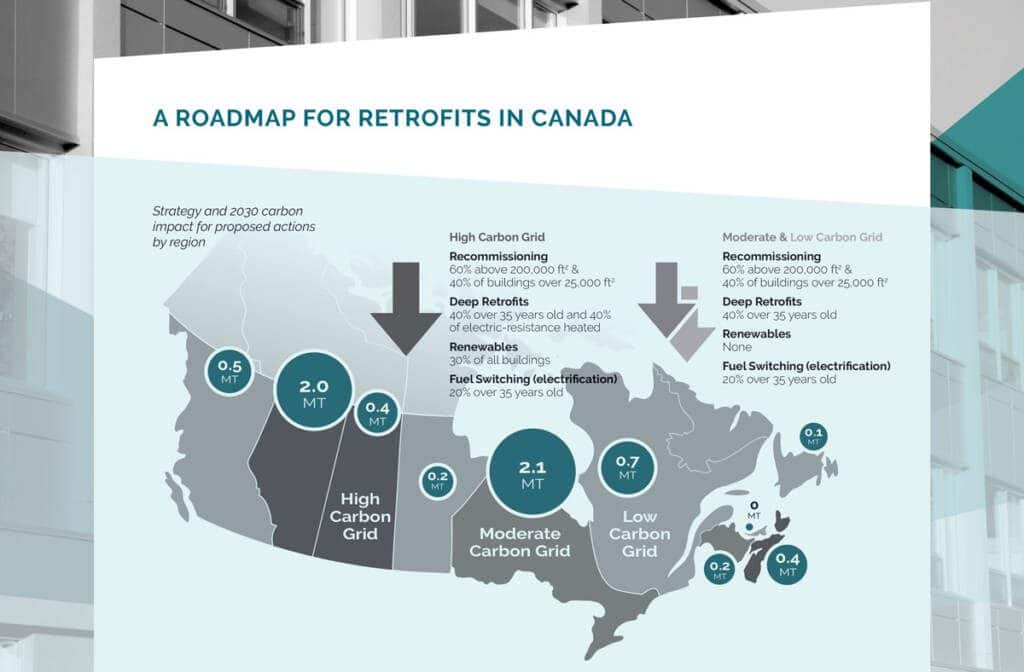Roadmap to Retrofits 2017
A detailed roadmap for reducing greenhouse gas emissions from large buildings.
CaGBC’s A Roadmap for Retrofits in Canada demonstrates the critical role that existing buildings play in realizing Canada’s low carbon future. The report provides recommendations to retrofit large buildings that will contribute to achieving a reduction in GHG emissions of at least 30 per cent (or 12.5 million tonnes[1]) by 2030, with the potential to reach 51 per cent or 21.2 million tonnes.
Developed with WSP, the new report advances recommendations made in CaGBC’s 2016 Buildings Solutions for Climate Change report by analyzing how the type, size, age, energy source and regional electrical grid of large buildings in Canada can affect efficiency performance and carbon emissions. The report identifies the buildings with the largest carbon reduction potential and recommends provincially-specific retrofit pathways that include a combination of recommissioningi, deep retrofitsii, renewable energyiii, and fuel switching actions1v.

Buildings including office buildings, shopping malls, universities, and arenas constructed between 1960 and 1979 across all provinces represent the age class with the largest opportunity for total carbon emissions reductions.

Alberta and Ontario currently emit the most carbon and therefore have the greatest potential for reducing emissions. This is due to the carbon intensity of Alberta’s electricity grid and the number of large buildings in Ontario.

All provinces will need to prioritize recommissioning for large buildings (between 25,000 and 200,000 sq.ft) and deep retrofits for older buildings (over 35 years old) in order to meet the target. These two actions will reduce emissions by a collective total of 4.1 MT CO2e, providing 62 per cent of the reduction activity needed.

Fuel switching must be completed in 20 per cent of buildings over 35 years old across Canada. Currently, fuel switching is particularly attractive in provinces with clean electricity grids such as British Columbia, Manitoba, Quebec, PEI and Newfoundland & Labrador. In these regions, significant effort should be put into increasing the adoption of highly efficient heat pump technology. This will reduce emissions by 1.6 MT CO2e, or 25 per cent of the reduction activity needed.

In provinces with carbon intense electricity grids, specifically Alberta, Saskatchewan, New Brunswick and Nova Scotia, 30 per cent of buildings will need to use renewable energy in order to meet the target. This will reduce emissions by 0.9 MT CO2e, representing 13 per cent of the reduction activity needed.

i Recommissioning: optimizing the performance and operation of an existing building’s system. Following investigation, the measures implemented can include equipment maintenance, adjustments to controls, and minor equipment retrofits. This includes things like upgrading lighting, improving indoor air quality and replacing boilers.
ii Deep retrofits involve major system and equipment replacement or upgrade. Typically pursued during building renewal events such as envelope and major equipment replacement, new ownership or occupancy, and green building certification. It can include HVAC changes, window replacement, and other envelope and system upgrades.
iii Renewable energy: while many forms of on-site renewable energy exist, including solar thermal, biomass, wind and micro-hydro, solar photovoltaic (PV) electricity generation is most commonly used in existing buildings.
iv Fuel switching actions: switching natural gas and other carbon-intensive heating furnaces, boilers and distributed equipment to low carbon sources like high-efficiency electricity-based systems such as heat pumps.